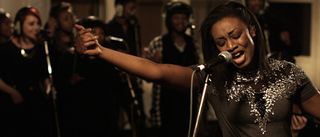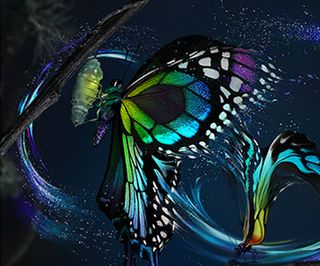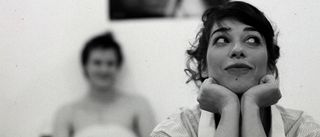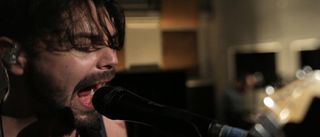INTERVIEW: Jonathan Walton on the evolution of music video
Jonathan Walton has brought some of the biggest names in the music business to our screens. We met him at Adobe's Creative Day event and chatted about editing software and getting up close and personal with rock stars.
They tell you at design school that if you want to get ahead, it helps to find a niche. And if you're looking for an example of that principle in action, look no further than British video editor Jonathan Walton. Over the last 10 years, he's made a name for himself by specialising in multicam music shows - and gone from first-job graduate to running his own, successful TV production company.
His firm, My Little Eye TV, has worked on shows for Channel 4, ITV1, the Sundance Channel and NBC, and with high profile artists including The Killers, David Bowie, Green Day, Kings of Leon and David Gilmour. It's all a far cry from his first job as a video QC at Abbey Road Studios, where he worked in one of the first DVD production departments in the country.
Early days
It may have cutting-edge technology back then, but the work was monotonous. "I just sat in front of a TV testing every button and every menu worked," he recalls. But Walton was determined to advance quickly. "I wanted get work doing the bonus features on videos," he explains. "Wherever I was, and whoever I was talking to, I'd go: 'I can do that, I can fix that'." His determination paid off, and he soon climbed to the position of senior editor, then struck out on his own in 2007.

Part of the reason things moved so quickly is that Walton established such an identifiable niche in music. "At Abbey Road, we did do feature films, we did O Brother, Where Art Thou and Amelie and stuff like that," he qualifies. "But we also got a lot of EMI in-house music stuff. And once you've worked there for seven years and you've got projects involving the Beatles, Coldplay, and so on, on your CV, then that's what you become known for."
Editing software
We're meeting at Adobe's Creative Day event, so it seems natural to ask Walton about his software preferences. It turns out he's had a longstanding, but on-off relationship with Adobe software, first using it as a student when he did his final dissertation film in 1999.

"At that time there wasn't a lot of tools to choose from," he explains. "There was Avid, which was the industry standard, but that was, you know, a hundred grand for the software and the hardware to run it. But you could get Adobe's software for about £500 and I just ran it on a PC from Tiny. I shot everything on DV and just loaded it into the computer and edited from there."
During his time at Abbey Road, Walton used After Effects, but after leaving, that's where the relationship ended - until very recently. In fact he's just returned to using Adobe tools since October last year.

Why the change? "Final Cut Pro ballsed up their release," he says, bluntly. He's referring to a widely held view in the professional video editing community that Apple's decision to release a scaled-back, prosumer version of Final Cut Pro with the release of Final Cut Pro X in 2011 was a misfire - and one that's led to Apple rereleasing the tool several times in the two years since.
Disillusioned with Final Cut Pro, Walton faced a dilemma. "We had a new show coming up for Channel 4," he explained. "And so I got talking to Adobe and just decided to edit on that."
Need for speed
My Little Eye TV had finished five series of a music TV show called Live from Abbey Road, which featured bands like The Macabees, Django Django and Paul Weller. It had been so successful that they'd got sponsorship for a new series (retitled 'Abbey Road Studios in Session with VW Beetle').
But there was one problem: "It was a really short production schedule. We normally have six months to do a 12-part series, and this was a eight-part series and we had to do it in two months.
"So the reason I used Adobe's Premiere was because it was the only editing software where you can work on the rushes from pretty much any camera, straight off the camera.

You don't have to do any transcoding or converting. And because we were just up against it time-wise, we didn't have time to convert rushes, I just had to edit it as soon as it came off. So we moved to that."
Innovative approach
We're glad they found a solution, because we're huge fans of the show at Creative Bloq. If you've not seen it, it takes an innovative approach to televised music in that there's no presenter. "Because of that, we're different from 99 per cent of all music shows," says Walton.
Something else that makes it unique is the way it's filmed. "We wanted to make the audience feel like they were in the room with the act," he explains.
"The minute you see other people sitting there, there's a barrier between the viewer and the act. So we're not about the big stage gigs. I've edited some of those and I always find it hard to feel like that song's for you, do you know what I mean? You know, a wide shot and you've got 100,000 people there, it doesn't make it feel very intimate.
"Our show's all about trying to create that level of intimacy. So we shoot on 5Ds, which are small DSLR cameras. That means we can get in really close. So if you see any of the shots from our show, we can get right in, on the floor, looking into the drumkit and everything else. We want people to feel that they're in the studio and that performance is just for them."

This can be a little intimidating for the musicians being filmed, of course. "It's often something they haven't had before," Walton smiles. "For instance, we had Biffy Clyro on. Our camera guy had a wide lens and the idea was, the closer you get, the focus fell off quickly, so for instance his nose and his eyes were in focus but his ear was out of focus. And to get the shot, the guy was about two inches away from the end of his nose.
"He said at the beginning: 'I'm going to get quite close to you'. And at the end of it the lead singer said: 'You said close, but I didn't think you meant THAT close!' But he was laughing about it - and when you see that shot, it really pays off."
- Not sure whether to sign up to Adobe's new Creative Cloud service? Read this interview with Adobe's Mala Sharma to find out more...

Thank you for reading 5 articles this month* Join now for unlimited access
Enjoy your first month for just £1 / $1 / €1
*Read 5 free articles per month without a subscription

Join now for unlimited access
Try first month for just £1 / $1 / €1
Get the Creative Bloq Newsletter
Daily design news, reviews, how-tos and more, as picked by the editors.
The Creative Bloq team is made up of a group of design fans, and has changed and evolved since Creative Bloq began back in 2012. The current website team consists of eight full-time members of staff: Editor Georgia Coggan, Deputy Editor Rosie Hilder, Ecommerce Editor Beren Neale, Senior News Editor Daniel Piper, Editor, Digital Art and 3D Ian Dean, Tech Reviews Editor Erlingur Einarsson and Ecommerce Writer Beth Nicholls and Staff Writer Natalie Fear, as well as a roster of freelancers from around the world. The 3D World and ImagineFX magazine teams also pitch in, ensuring that content from 3D World and ImagineFX is represented on Creative Bloq.
